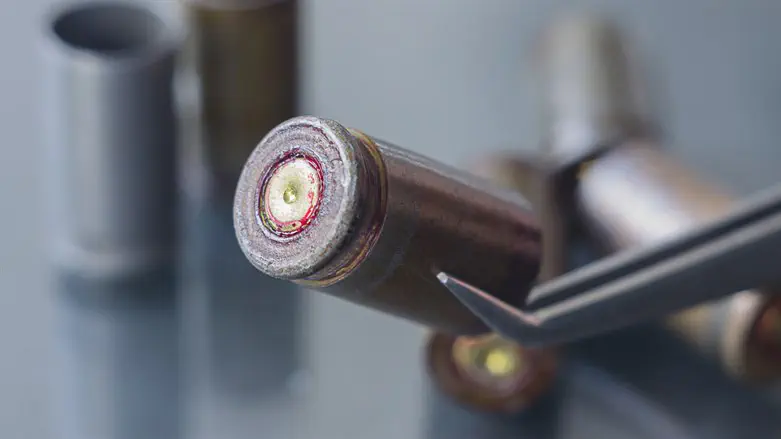
The New York Times has come under fire for publishing a guest essay last week titled "65 Doctors, Nurses and Paramedics: What We Saw in Gaza," accusing Israeli soldiers of deliberately shooting Gazan children in the head that included images of X-rays that experts say look doctored.
The media watchdog group Honest Reporting highlighted multiple analyses of the images of bullets in the skulls or necks of children that concluded they were faked.
One image, which shows a bullet in the middle of a child's skull, was the focus of several of these analyses showing it to have been doctored. The bullet shown, a 5:56 caliber round, was stated by multiple military and forensics ballistics experts to be expected to cause substantially more damage to the skull than was shown.
Col. Richard Kemp, the former commander of the British armed forced in Afghanistan, noted that even if the images were real, the piece presented no evidence that the children were deliberately shot by Israeli soldiers rather than by Hamas terrorists or struck by ricochets.
"Nothing here is proof of war crimes by the IDF. This x-ray, which looks suspicious anyway, certainly doesn’t prove it. Who is to say the head shots were not Hamas fire, either deliberately or unintentionally aimed at their own children? Hamas do use 5.56 as well as other calibres and they do murder their own people. If Israeli, who is to say whether they were crossfire, ricochet or otherwise not deliberately targeted and therefore not necessarily war crimes? Children can and have carried out terrorist acts for Hamas and therefore can be legitimate targets, no matter how tragic that is, including for the soldiers who are forced to deal with them," Co. Kemp wrote.
Matt Tardio, a former sniper in the US military and host of the Speak the Truth podcast series, wrote on X, "As a former Law Enforcement Officer, Ret. Special Forces Soldier (Green Beret) and Sniper, I feel confident in saying I know the effects of 5.56 NATO (M855)."
"Conclusion: The NYT lied or failed to verify the information presented to them. This is based on the MV and BC of the M855 Ball ammo currently being used by the IDF," he stated.
He went into detail as to why the bullet in the image could not stop in a child's head as depicted in the X-ray images. "An M4 shooting the M855 round has an average accuracy of around 4 Minutes Of Angle. That is roughly a 4-inch shot group at 100 yards. At 200 yards, the shot group expands to 8 inches. At 300 yards, it increases to 12 inches. The average diameter of the adult male head is about 8 inches. The size of a child's head will vary based on age. Hitting a 4-inch to 8-inch target at greater than 100 meters with an M4 is a challenge on the range with stationary targets. In combat conditions with moving targets, it would be almost impossible."
He emphasized, "The M855 travels too fast at that range and is designed to penetrate. It would easily, without question, pass completely through a child's skull at those ranges. This leads to the next question."
Tardio further stated that the bullet could not have struck the child in the image as the result of a ricochet, which would have slowed it down, because it is in perfect shape in the image, while it would have been deformed if it had ricocheted.
Another X user, Cheryl E, who states that she is a forensic ballistics expert, also wrote a detailed post elaborating on why the damage to the skull is inconsistent with the bullet shown in the image.
"The most important factor that determines the level of damage is velocity. And a 5.56 caliber high velocity rifle as is used by the IDF will therefore have a high degree of damage to the head and skull. None of the most obvious types of damage from any gunshot wound to the head nevertheless a 5.56 high velocity rifle shot are visible," she wrote.
She explained, "When the bullet hits the skull at high velocity, it bevels into the skull, which means as it’s passing through the skull, the immediate entry is small and clean whereas the exit at the front of the skull inside the head is wider and flared. It splinters the skull bone on entry and creates bone shards that then move with the bullet and cause even more damage."
She elaborated,"Once the bullet enters the head, especially at high velocity, it heats up and creates a shockwave in front of the bullet which widens as the bullet travels through the head causing more damage. The brain is a solid, soft and highly inelastic organ, which means the damage to the brain is such that it literally mushes. The shockwave on entry causes external gases to enter the head in front of the bullet and thus significant displacement of brain matter very rapidly which in turn causes the head to expand rapidly thus causing primary and secondary fractures in various areas of the skull. NONE such fractures are visible in these X-rays."
According to her, "Back to the velocity of the 5.56 rifle shot, for any bullet to stop in the area shown in any of the X-ray images, the bullets would need to travel at very low velocity. That means either the bullets were fired by low velocity small caliber pistols or the rifle shots would need to have been fired from a very long distance (many hundreds of meters) with pinpoint accuracy. When looking at the images, the caliber of bullets are not the same. The first image has a much shorter bullet than the second, meaning it could not be the same caliber."
"Now if the children were deliberately shot in the head and neck, it would mean it would be from close range. With a high velocity 5.56 rifle of the type the IDF use, the bullet would never stop so quickly, ever. The bullet would travel so quickly due to VELOCITY that they would almost always exit the skull or body causing much larger exit wounds. None are visible as the bullets are all magically stopped for the perfect X-ray pose. As you can see, there is no damage to the brain in the X-rays. This is even more true of the neck shots where the bullets barely travel an inch and stop at the spine. This would happen only with very low velocity small caliber handguns such as .22 caliber pistols.
"Basically, for any of the X-rays to be true, these would need to be low velocity pistols, and not high velocity rifles. The distance of fire would still not be very close range, as the damage is not significant enough. Very close range has higher velocity thus more damage," she said.
A third user who stated he is a radiologist wrote, "I believe the images are fake because there is only one view available for all cases and the edge of the bullets is irregular while the edge of bones is smooth."
He also showed how there was no entry wound along the path the bullet would have taken into the skull.
Other users posted X-rays of skulls that were actually struck by 5:56 caliber rounds, which showed significantly more damage as well as large exit wounds in addition to the entry wounds.
Honest Reporting also criticized the piece's author, Dr. Feroze Sidhwa, for posts denying the fact that Hamas uses human shields, demonstrating a bias in favor of the terrorist organization.
"To deny that Hamas use civilians as human shields and claim Israel does, as well as denying that “maximizing civilian deaths” is in Hamas’ interests is not only delusional, it is an intentional, blatant lie. There are countries, journalists and international bodies, the UN included, which have confirmed the use of human shields. Hamas leaders, like Yahya Sinwar, have even been outspoken on the role innocent civilians play in their strategy to defeat Israel," Honest Reporting wrote.
In addition, Honest Reporting noted that the doctors cited in the piece belong to the Palestinian American Medical Association (PAMA), an organization Honest Reporting stated is tied to the Council on American-Islamic Relations (CAIR), which itself is mired in accusations of antisemitism and ties to terrorist organizations.
Honest reporting stated that the "lesson" the Times should learn is to "consider your sources, and no mission that seems righteous should come at the expense of your publication’s integrity. Just because a claim fits your ideological worldview on Israel, it doesn’t remove the obligation to fact-check and do journalistic due diligence."
The New York Times stated in response to the questions on the images' veracity, "A recent opinion essay gathered first-hand testimonies from 65 U.S.-based health professionals who worked in Gaza over the past year, who shared more than 160 photographs and videos with Times Opinion to corroborate their detailed accounts of treating preteen children who were shot in the head or chest. Following publication, some readers questioned the accuracy of the accounts and the authenticity of three CT images shown. Those criticisms are unfounded."
"Times Opinion rigorously edited this guest essay before publication, verifying the accounts and imagery through supporting photographic and video evidence and file metadata. We also vetted the doctors and nurses’ credentials, including that they had traveled to and worked in Gaza as claimed. When questions arose about the veracity of images included in the essay, we did additional work to review our previous findings. We presented the scans to a new round of multiple, independent experts in gunshot wounds, radiology and pediatric trauma, who attested to the images’ credibility. In addition, we again examined the images’ digital metadata and compared the images to video footage of their corresponding CT scans as well as photographs of the wounds of the three young children.
"While our editors have photographs to corroborate the CT scan images, because of their graphic nature, we decided these photos — of children with gunshot wounds to the head or neck — were too horrific for publication. We made a similar decision for the additional 40-plus photographs and videos supplied by the doctors and nurses surveyed that depicted young children with similar gunshot wounds.
"We stand behind this essay and the research underpinning it. Any implication that its images are fabricated is simply false."

